Use of Wild Edible Plants: Can They Meet the Dietary and Nutritional Needs of Indigenous Communities in Central India
Abstract
1. Introduction
2. Material and Methods
2.1. Study Area and Geographic Location of Research Site and Native Communities
2.2. Sampling of Villages
2.3. Determination of Sample Size and Sampling of Households
2.4. Survey on Collection, Consumption and Marketing of Wild Edible Plants (WEPs)
2.5. Dietray Consumption and Nutrtion
2.6. Statistical Analysis
3. Results
3.1. Community Profile and Socio-Economics
3.2. Utilization of Wild Edible Plant Resources
3.2.1. Wild Leafy Vegetables
3.2.2. Wild Edible Flowers, Fruits, Seeds and Nuts
3.2.3. Underground Stem, Tubers, Rhizomes and Bulbs
3.2.4. Mushrooms
3.2.5. Household Consumption, Trading, Income Generation and Potential Threats to WEPs
3.3. Consumption Pattern of Diverse Food Groups and Intake Pattern of Nutrients
4. Discussion
4.1. Household Income and Contribution of Wild Edibles
4.2. Food and Nutrition Intake
5. Conclusions
Supplementary Materials
Author Contributions
Funding
Institutional Review Board Statement
Informed Consent Statement
Data Availability Statement
Acknowledgments
Conflicts of Interest
References
- Pretty, J.; Adams, B.; Berkes, F.; De Athayde, S.F.; Dudley, N.; Hunn, E.; Pilgrim, S. The intersections of biological diversity and cultural diversity: Towards integration. Conserv. Soc. 2009, 7, 100–112. [Google Scholar]
- Cuni-Sanchez, A.; Pfeifer, M.; Marchant, R.; Burgess, N.D. Ethnic and locational differences in ecosystem service values: Insights from the communities in forest islands in the desert. Ecosyst. Serv. 2016, 19, 42–50. [Google Scholar] [CrossRef]
- Watson, K.B.; Galford, G.L.; Sonter, L.J.; Ricketts, T.H. Conserving ecosystem services and biodiversity: Measuring the tradeoffs involved in splitting conservation budgets. Ecosyst. Serv. 2020, 42, 101063. [Google Scholar] [CrossRef]
- Bhat, J.A.; Kumar, M.; Negi, A.; Todaria, N.; Malik, Z.A.; Pala, N.A.; Kumar, A.; Shukla, G. Altitudinal gradient of species diversity and community of woody vegetation in the Western Himalayas. Glob. Ecol. Conserv. 2020, 24, e01302. [Google Scholar] [CrossRef]
- Mahapatra, A.K.; Panda, P.C. Wild edible fruit diversity and its significance in the livelihood of indigenous tribals: Evidence from eastern India. Food Secur. 2012, 4, 219–234. [Google Scholar] [CrossRef]
- Mavengahama, S.; McLachlan, M.; De Clercq, W. The role of wild vegetable species in household food security in maize based subsistence cropping systems. Food Secur. 2013, 5, 227–233. [Google Scholar] [CrossRef]
- Kumar, Y.; Thakur, T. Agroforestry: Viable and Futuristic Option for Food Security and Sustainability in India. Int. J. Curr. Microbiol. Appl. Sci. 2017, 6, 210–222. [Google Scholar] [CrossRef]
- Wang, J.; Seyler, B.C.; Ticktin, T.; Zeng, Y.; Ayu, K. An ethnobotanical survey of wild edible plants used by the Yi people of Liangshan Prefecture, Sichuan Province, China. J. Ethnobiol. Ethnomed. 2020, 16, 1–27. [Google Scholar] [CrossRef] [PubMed]
- Powell, B.; Thilsted, S.H.; Ickowitz, A.; Termote, C.; Sunderland, T.; Herforth, A. Improving diets with wild and cultivated biodiversity from across the landscape. Food Secur. 2015, 7, 535–554. [Google Scholar] [CrossRef]
- Landis, B.; Fontenot, C. Feasibility of Wild Edible Plants to Address Nutrition and Food Insecurity Issues. J. Acad. Nutr. Diet. 2016, 116, A52. [Google Scholar] [CrossRef]
- Aryal, K.P.; Poudel, S.; Chaudhary, R.P.; Chettri, N.; Chaudhary, P.; Ning, W.; Kotru, R. Diversity and use of wild and non-cultivated edible plants in the Western Himalaya. J. Ethnobiol. Ethnomed. 2018, 14, 10. [Google Scholar] [CrossRef]
- Kuhnlein, H.; Erasmus, B.; Spigelski, D. Indigenous Peoples’ Food Systems; FAO: Rome, Italy, 2009. [Google Scholar]
- Bharucha, Z.; Pretty, J. The roles and values of wild foods in agricultural systems. Philos. Trans. R. Soc. B Biol. Sci. 2010, 365, 2913–2926. [Google Scholar] [CrossRef]
- Ong, H.G.; Kim, Y.D. The role of wild edible plants in household food security among transitioning hunter-gatherers: Evidence from the Philippines. Food Secur. 2017, 9, 11–24. [Google Scholar] [CrossRef]
- Uprety, Y.; Poudel, R.C.; Shrestha, K.K.; Rajbhandary, S.; Tiwari, N.N.; Shrestha, U.B.; Asselin, H. Diversity of use and local knowledge of wild edible plant resources in Nepal. J. Ethnobiol. Ethnomed. 2012, 8, 1–15. [Google Scholar] [CrossRef]
- Census. Primary Census Abstracts, Registrar General of India, Ministry of Home Affairs, Government of India. Available online: http://www.censusindia.gov.in/2011census/PCA/pca_highlights/pe_data (accessed on 10 April 2021).
- Yesodharan, K.; Sujana, K.A. Wild edible plants traditionally used by the tribes in the Parambikulam Wildlife Sanctuary, Kerala, India. Indian J. Nat. Prod. Res. 2007, 6, 74–80. [Google Scholar]
- Basu, A.; Mukherjee, N.; Roy, S.; Sengupta, S.; Banerjee, S.; Chakraborty, M.; Majumder, P.P. Ethnic India: A genomic view, with special reference to peopling and structure. Genome Res. 2003, 13, 2277–2290. [Google Scholar] [CrossRef] [PubMed]
- Das, S.; Bose, K. Adult tribal malnutrition in India: An anthropometric and socio-demographic review. Anthropol. Rev. 2015, 78, 47–65. [Google Scholar] [CrossRef]
- Thakur, T.; Kumar, Y.; Bijalwan, A.; Dobriyal, M.J.R. Traditional Uses and Sustainable Collection of Ethnobotanicals by Aboriginal Communities of the Achanakmaar Amarkantak Biosphere Reserve of India. Front. Environ. Microbiol. 2017, 3, 39–49. [Google Scholar] [CrossRef][Green Version]
- Srivastava, A.; Patel, S.P.; Mishra, R.K.; Vashistha, R.K.; Singh, A.; Puskar, A.K. Ethnomedicinal importance of the plants of Amarkantak region, Madhya Pradesh, India. Int. J. Med. Arom. Plants 2012, 2, 53–59. [Google Scholar]
- Mishra, M. Utilization of wild tuberous plants in extreme environmental conditions: A case of Baiga tribe of central India. J. Ethnobiol. Tradit. Med. 2013, 118, 366–372. [Google Scholar]
- Bultosa, G.; Molapisi, M.; Tselaesele, N.; Kobue-Lekalake, R.; Haki, G.D.; Makhabu, S.; Nthoiwa, G.P. Plant-based traditional foods and beverages of Ramotswa Village, Botswana. J. Ethn. Foods 2020, 7, 1–15. [Google Scholar] [CrossRef]
- Darro, H.; Swamy, S.L.; Thakur, T.K.; Mishra, A. Floristic Composition, Structure, Diversity and Conservation Strategies for Rehabilitation of Dry Tropical Forests in Buffer Zone of Achanakmaar Amarkantak Biosphere Reserve (AABR), India. Int. J. Curr. Microbiol. App. Sci. 2020, 9, 650–663. [Google Scholar] [CrossRef]
- Thakur, T.K.; Patel, D.K.; Bijalwan, A.; Dobriyal, M.J.; Kumar, A.; Thakur, A.; Bohra, A.; Jahangeer, B. Land use land cover change detection through geospatial analysis in an Indian Biosphere Reserve. Trees For. People 2020, 2, 100018. [Google Scholar] [CrossRef]
- Snedecor, G.W.; Cochran, W.G. Statistical Methods, 8th ed.; Iowa State University Press: Ames, IA, USA, 1989. [Google Scholar]
- ICMR-NIN. Nutrient Requirements for Indians-Recommended Dietary Allowances (RDA)—A Report of the Expert Group; Ministry of Health and Family Welfare, Government of India: New Delhi, India, 2020.
- ICMR-NIN. Recommended Dietary Allowances (RDA) and Estimated Average Requirements Nutrient Requirements for Indians. A Report of the Expert Group; Ministry of Health and Family Welfare, Government of India: New Delhi, India, 2020.
- ICMR-NIN. Dietary Guidelines for Indians—A Manual; Ministry of Health and Family Welfare, Government of India: New Delhi, India, 2011.
- Longvah, T.; Ananthan, R.; Bhaskarachary, K.; Venkaiah, K. Indian Food Composition Tables; International Institute of Nutrition: Hyderabad, India, 2017. [Google Scholar]
- Mudambi, S.R.; Rajagopal, M.V. Fundamentals of Foods, Nutrition and Diet Therapy, 5th ed.; New Age International Publishers: New Delhi, India, 2007. [Google Scholar]
- Misra, S.; Maikhuri, R.K.; Kala, C.P.; Rao, K.S.; Saxena, K.G. Wild leafy vegetables: A study of their subsistence dietetic support to the inhabitants of Nanda Devi Biosphere Reserve, India. J. Ethnobiol. Ethnomed. 2008, 4, 1–9. [Google Scholar] [CrossRef]
- Banik, A.; Nema, S.; Shankar, D. Wild edible tuber and root plants available in Bastar region of Chhattisgarh. Int. J. For. Crop Improv. 2014, 5, 85–89. [Google Scholar] [CrossRef]
- Chauhan, S.H.; Yadav, S.; Takahashi, T.; Łuczaj, Ł.; D’Cruz, L.; Okada, K. Consumption patterns of wild edibles by the Vasavas: A case study from Gujarat, India. J. Ethnobiol. Ethnomed. 2018, 14, 1–20. [Google Scholar] [CrossRef]
- Thakur, T.K. Diversity, composition and structure of understorey vegetation in the tropical forest of Achanakmaar Biosphere Reserve, India. Environ. Sustain. 2018, 1, 279–293. [Google Scholar] [CrossRef]
- Arinathan, V.; Mohan, V.R.; Britto, A.; Murugan, C. Wild edibles used by Palliyars of the Western Ghats, Tamil Nadu. Indian J. Tradit. Knowl. 2007, 6, 163–168. [Google Scholar]
- Ghorbani, A.; Langenberger, G.; Sauerborn, J. A comparison of the wild food plant use knowledge of ethnic minorities in Naban River Watershed National Nature Reserve, Yunnan, SW China. J. Ethnobiol. Ethnomed. 2012, 8, 1–10. [Google Scholar] [CrossRef]
- Kala, C.P. Aboriginal uses and management of ethnobotanical species in deciduous forests of Chhattisgarh state in India. J. Ethnobiol. Ethnomed. 2009, 5, 1–9. [Google Scholar] [CrossRef] [PubMed]
- Termote, C.; Van Damme, P.; Djailo, B.D.A. Eating from the wild: Turumbu, Mbole and Bali traditional knowledge on non-cultivated edible plants, District Tshopo, DRCongo. Genet. Resour. Crop Evol. 2011, 58, 585–618. [Google Scholar] [CrossRef]
- Saha, R.; Bhattacharya, P. Biodiversity Register and Indigenous Knowledge: A Case Study of Baigachak Area, in Dindori District of Madhya Pradesh. J. Biodivers. 2011, 2, 127–140. [Google Scholar] [CrossRef]
- Cuni-Sanchez, A.; White, L.J.T.; Calders, K.; Jeffery, K.J.; Burt, A.; Disney, M.; Gilpin, M.; Gomez-Dans, J.L.; Lewis, S.L. Data from: African savanna-forest boundary dynamics: A 20-year study. For. Plots 2016. [Google Scholar] [CrossRef]
- Kumar, Y.; Kumar, B.; Chandraker, S.K.; Padwar, G.K.; Dubey, A.K.; Thakur, T.; Sahu, M.L. Mahua (Madhuca indica) (Koenig) J.F. Macribide) A Nature, Reward to Tribal Ecosystem of Central India. Int. J. Curr. Microbiol. Appl. Sci. 2017, 6, 1519–1526. [Google Scholar] [CrossRef]
- Sundriyal, M.; Sundriyal, R.C. Wild edible plants of the Sikkim Himalaya: Marketing, value addition and implications for management. Econ. Bot. 2004, 58, 300–315. [Google Scholar] [CrossRef]
- Lepcha, L.D.; Shukla, G.; Pala, N.A.; Vineeta; Pal, P.K.; Chakravarty, S. Contribution of NTFPs on livelihood of forest-fringe communities in Jaldapara National Park, India. J. Sustain. For. 2019, 38, 213–229. [Google Scholar] [CrossRef]
- Neudeck, L.; Avelino, L.; Bareetseng, P.; Ngwenya, B.N.; Motsholapheko, M. The contribution of edible wild plants to food security, dietary diversity and income of households in Shorobe Village, northern Botswana. Ethnobot. Res. Appl. 2012, 10, 449–462. [Google Scholar]
- Ahirwar, R.; Mondal, P.R. Prevalence of obesity in India: A systematic review. Res. Rev. 2019, 13, 318–321. [Google Scholar] [CrossRef] [PubMed]
- Rao, K.M.; Balakrishna, N.; Laxmaiah, A.; Venkaiah, K.; Brahmam, G.N.V. Diet and nutritional status of adolescent tribal population in nine states of India. Asia Pac. J. Clin. Nutr. 2006, 15, 64. [Google Scholar]
- Chakma, T.; Meshram, P.; Kavishwar, A.; Vinay Rao, P.; Rakesh, B. Nutritional Status of Baiga Tribe of Baihar, District Balaghat, Madhya Pradesh. J. Nutr. Food Sci. 2014, 4, 275. [Google Scholar]
- Shirisha, P. Socioeconomic determinants of nutritional status among ‘Baiga’tribal children In Balaghat district of Madhya Pradesh: A qualitative study. PLoS ONE 2019, 14, e0225119. [Google Scholar]
- Boedecker, J.; Termote, C.; Assogbadjo, A.E.; Van Damme, P.; Lachat, C. Dietary contribution of Wild Edible Plants to women’s diets in the buffer zone around the Lama forest, Benin–an underutilized potential. Food Secur. 2014, 6, 833–849. [Google Scholar] [CrossRef]
- Jain, A.K.; Tiwari, P. Nutritional value of some traditional edible plants used by tribal communities during emergency with reference to Central India. Indian J. Tradit. Knowl. 2012, 11, 51–57. [Google Scholar]
- Egoh, B.N.; O’Farrell, P.J.; Charef, A.; Gurney, L.J.; Koellner, T.; Abi, H.N.; Willemen, L. An African account of ecosystem service provision: Use, threats and policy options for sustainable livelihoods. Ecosyst. Serv. 2012, 2, 71–81. [Google Scholar] [CrossRef]
- Kenter, J.O.; Bryce, R.; Christie, M.; Cooper, N.; Hockley, N.; Irvine, K.N.; Watson, V. Shared values and deliberative valuation: Future directions. Ecosyst. Serv. 2016, 21, 358–371. [Google Scholar] [CrossRef]
- Chaudhary, S.; McGregor, A.; Houston, D.; Chettri, N. Environmental justice and ecosystem services: A disaggregated analysis of community access to forest benefits in Nepal. Ecosyst. Serv. 2018, 29, 99–115. [Google Scholar] [CrossRef]
- Murali, R.; Suryawanshi, K.; Redpath, S.; Nagendra, H.; Mishra, C. Changing use of ecosystem services along a rural-urban continuum in the Indian Trans-Himalayas. Ecosyst. Serv. 2019, 40, 101030. [Google Scholar] [CrossRef]
- Thakur, T.K.; Padwar, G.K.; Patel, D.K. Monitoring land use, species composition and diversity of dry tropical environ in Achanakmaar Amarkantak Biosphere Reserve, India using satellite data. Biodivers. Int. J. 2019, 3, 162–172. [Google Scholar] [CrossRef]
- Sahoo, G.; Swamy, S.L.; Mishra, A.; Thakur, T.K. Effect of seed source, light and nitrogen levels on biomass and nutrient allocation pattern in seedlings of Pongamia pinnata. Environ. Sci. Pollut. Res. 2020. [Google Scholar] [CrossRef]
- Bijalwan, A.; Bahuguna, K.; Vasishth, A.; Singh, A.; Chaudhary, S.; Dongariyal, A.; Thakur, T.K.; Kaushik, S.; Ansari, M.J.; Alfarraj, S.; et al. Growth Performance of Ganoderma lucidum using billet method in Garhwal Himalaya, India. Saudi J. Biol. Sci. 2021, 28, 2709–2717. [Google Scholar] [CrossRef]
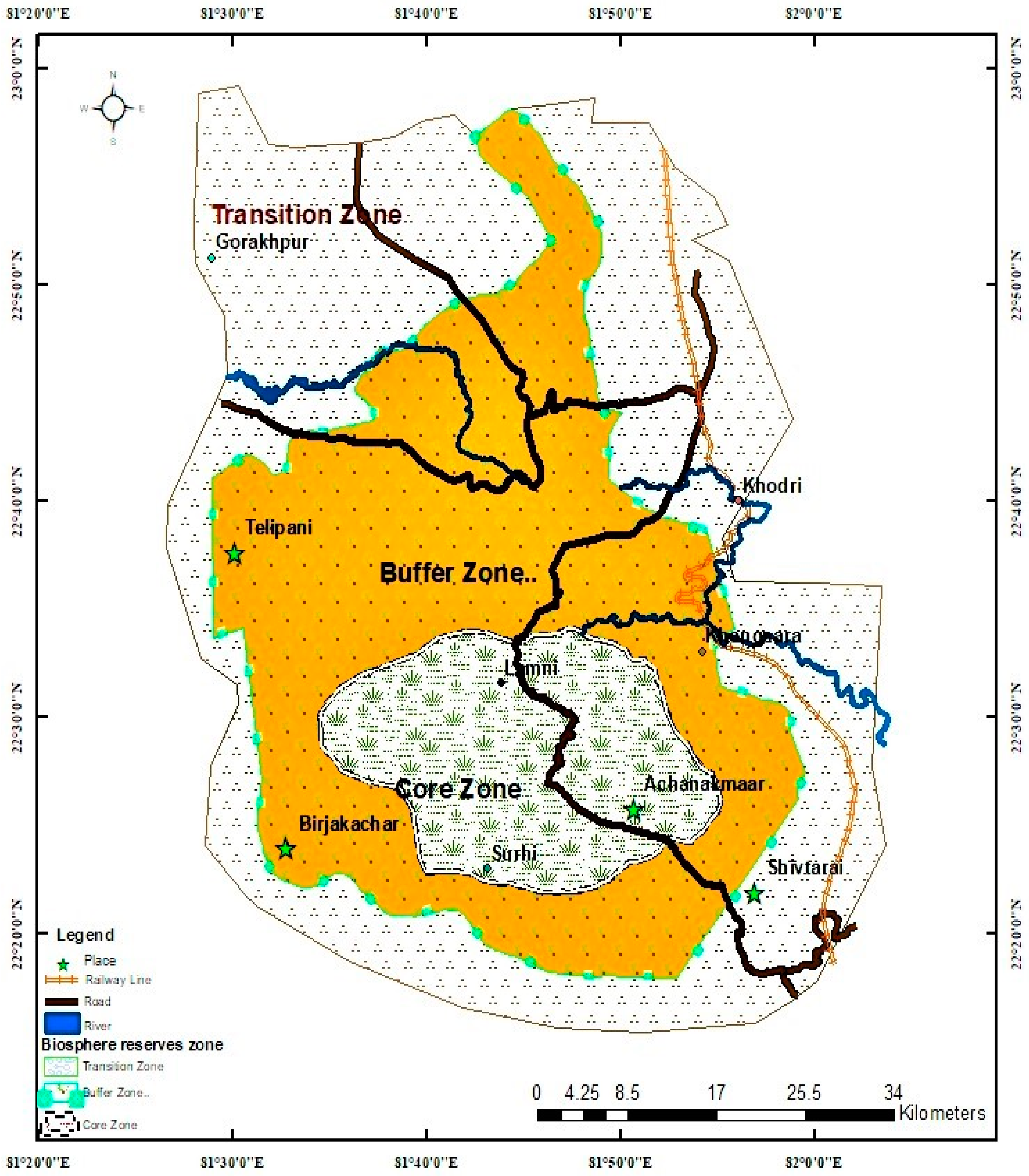
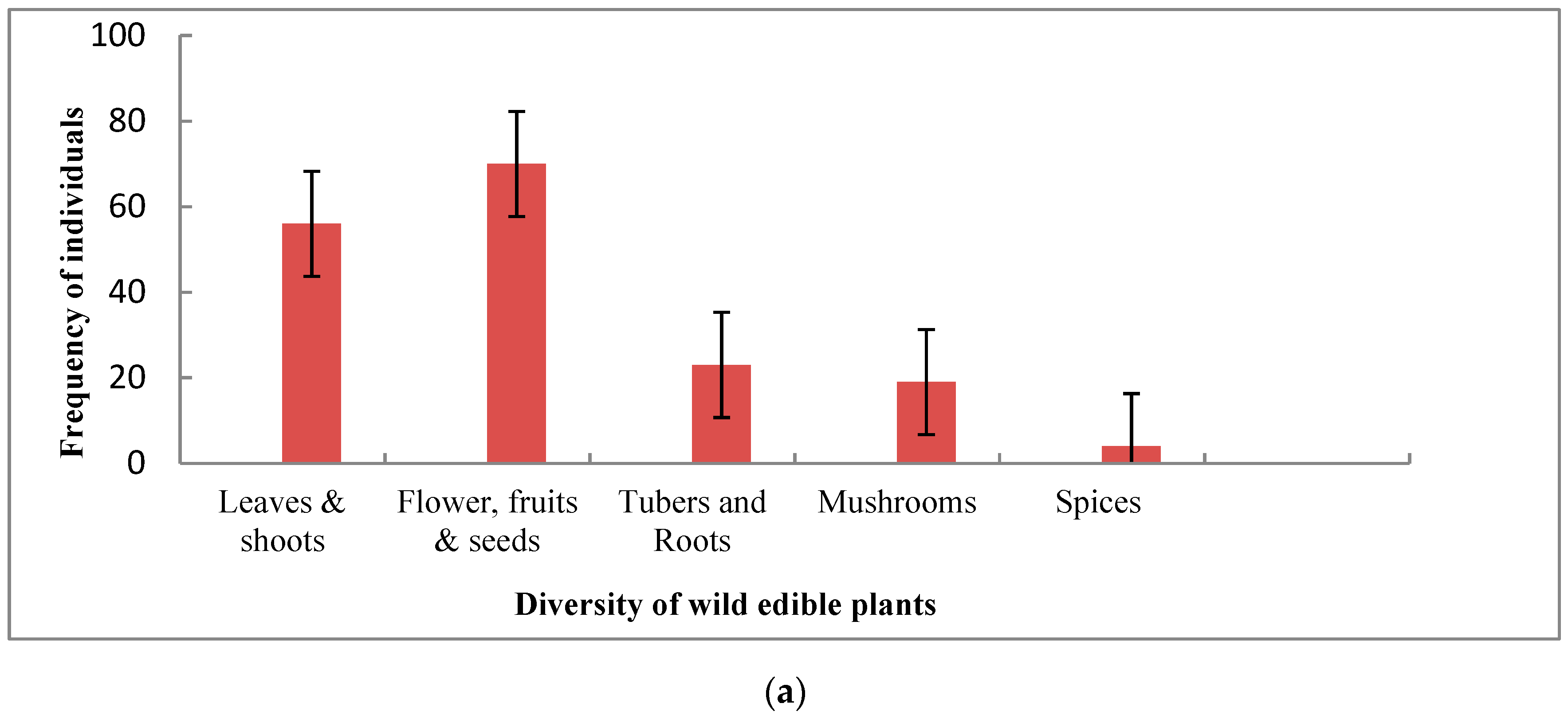
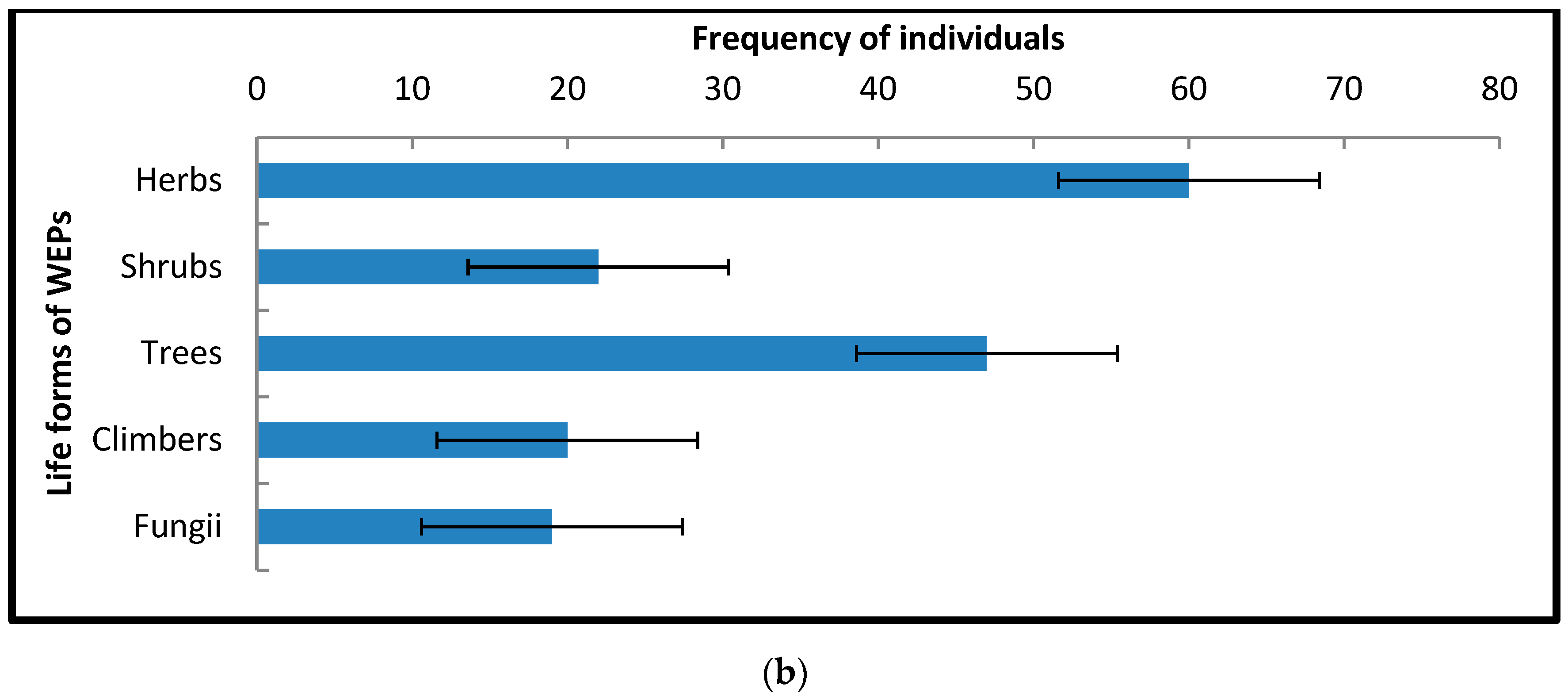
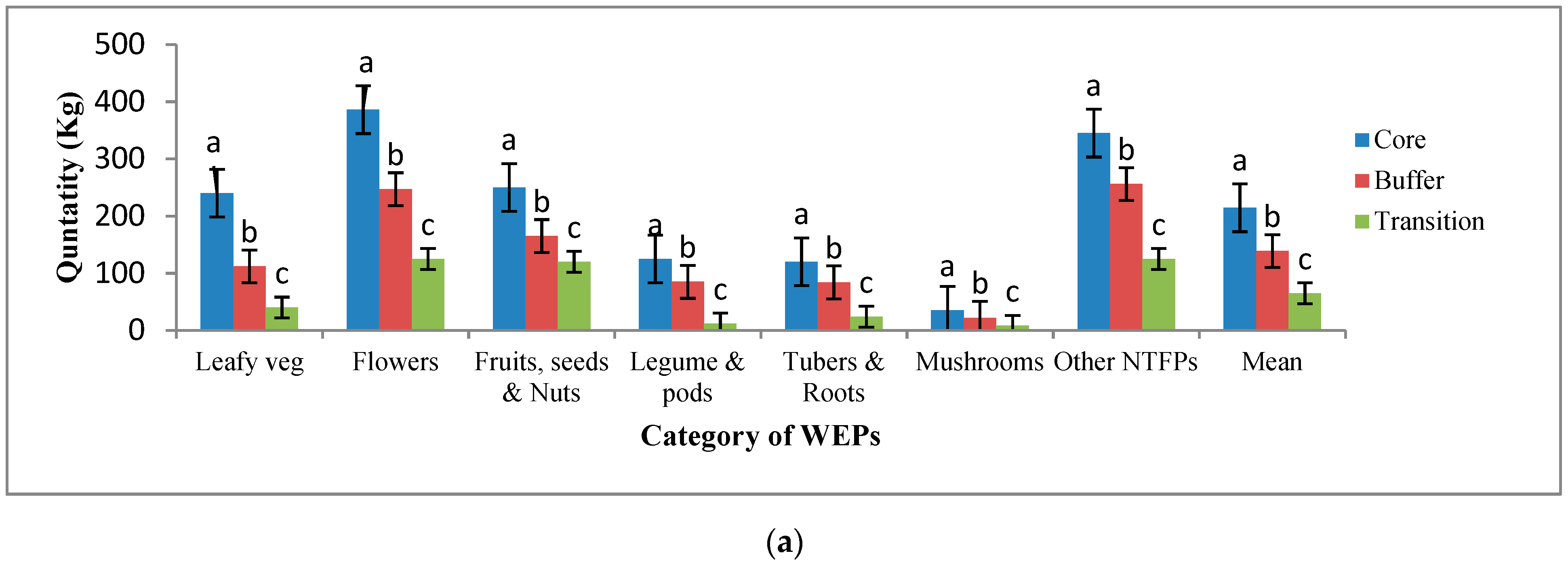
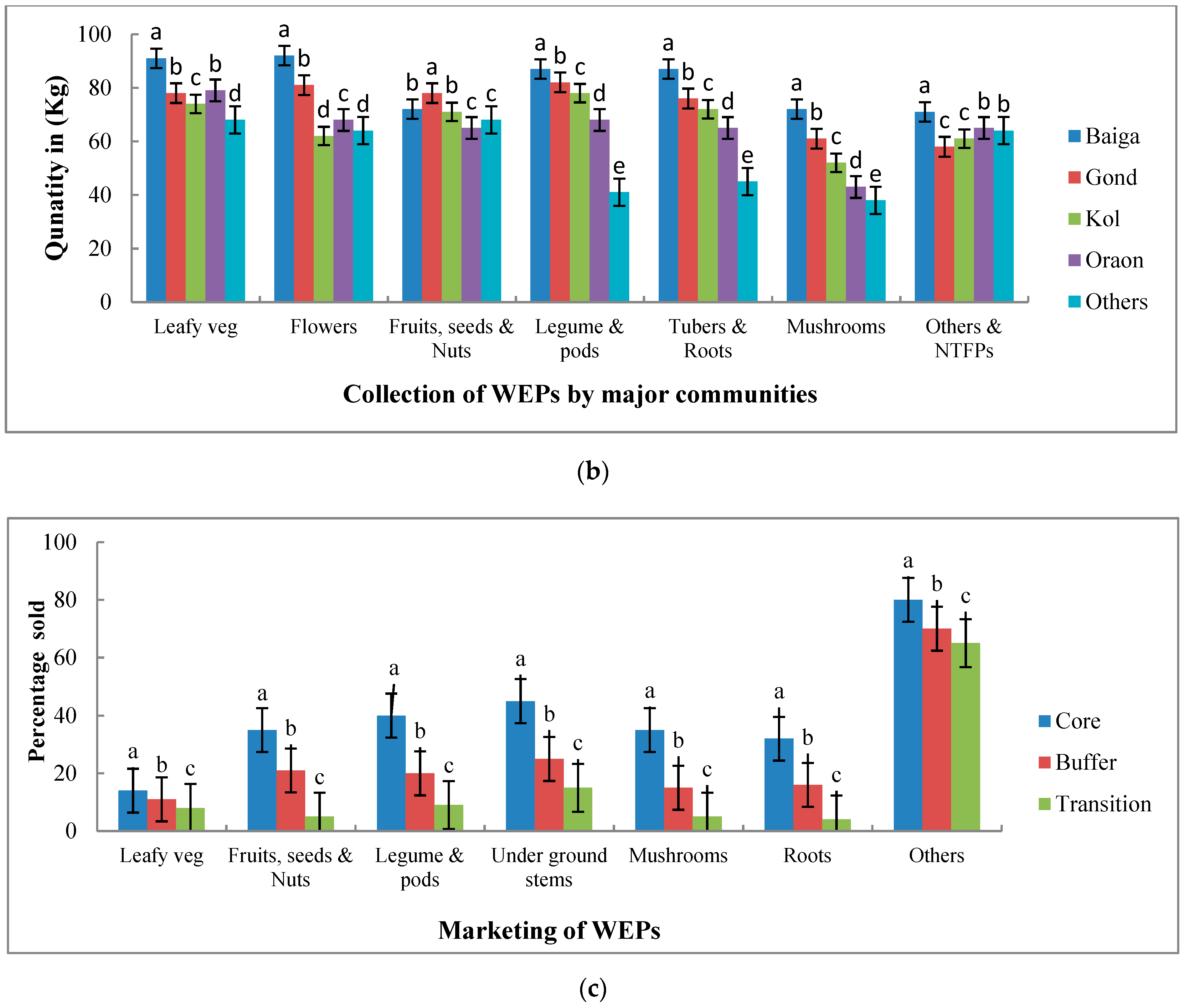
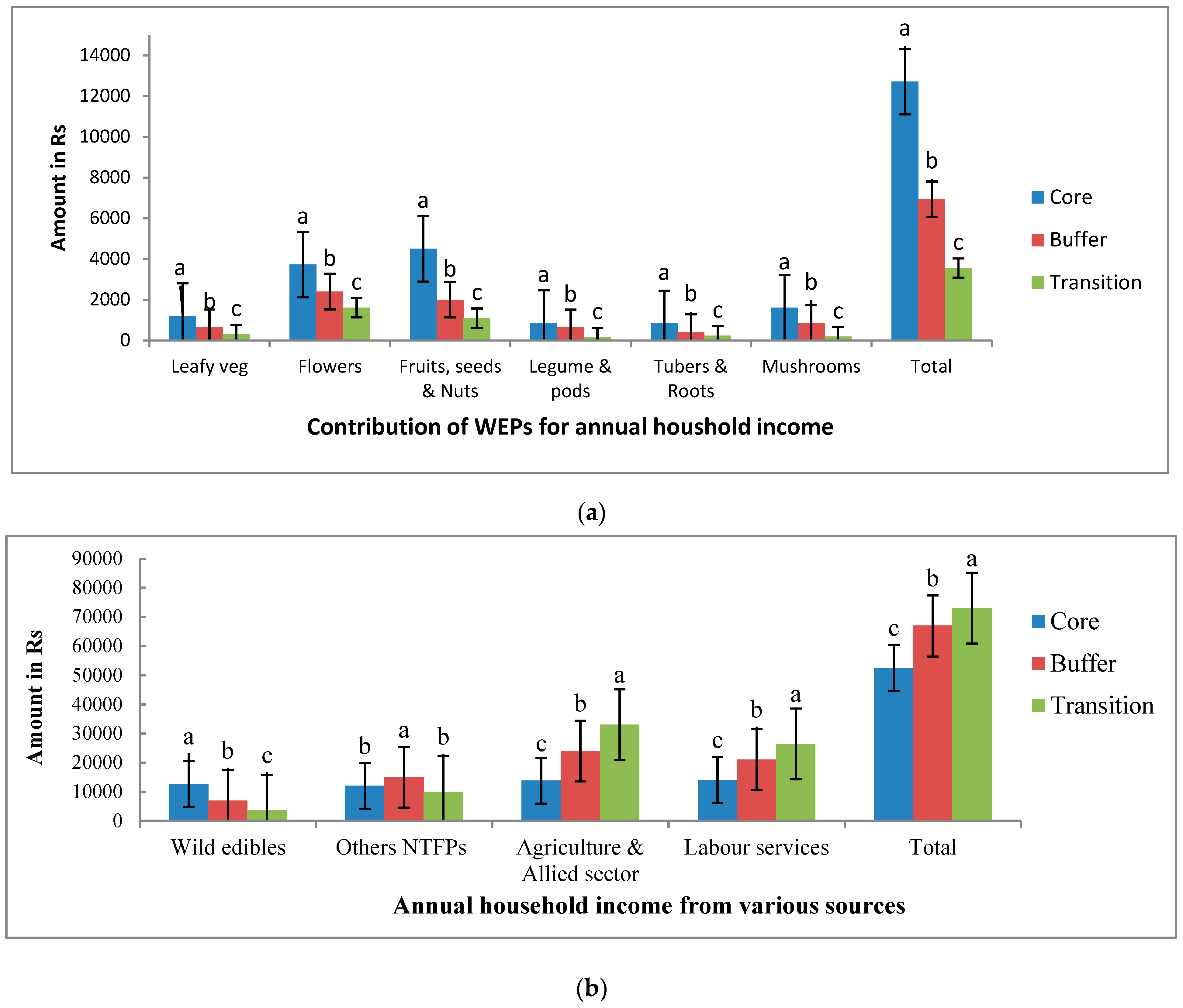

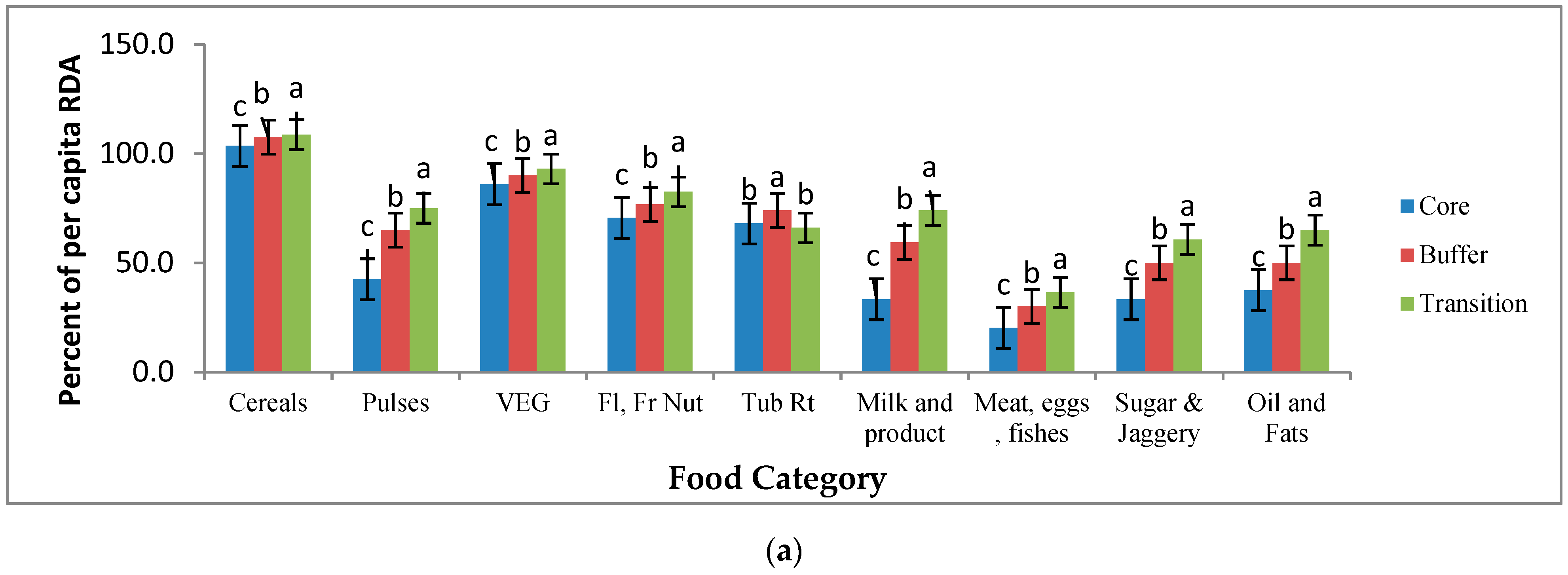
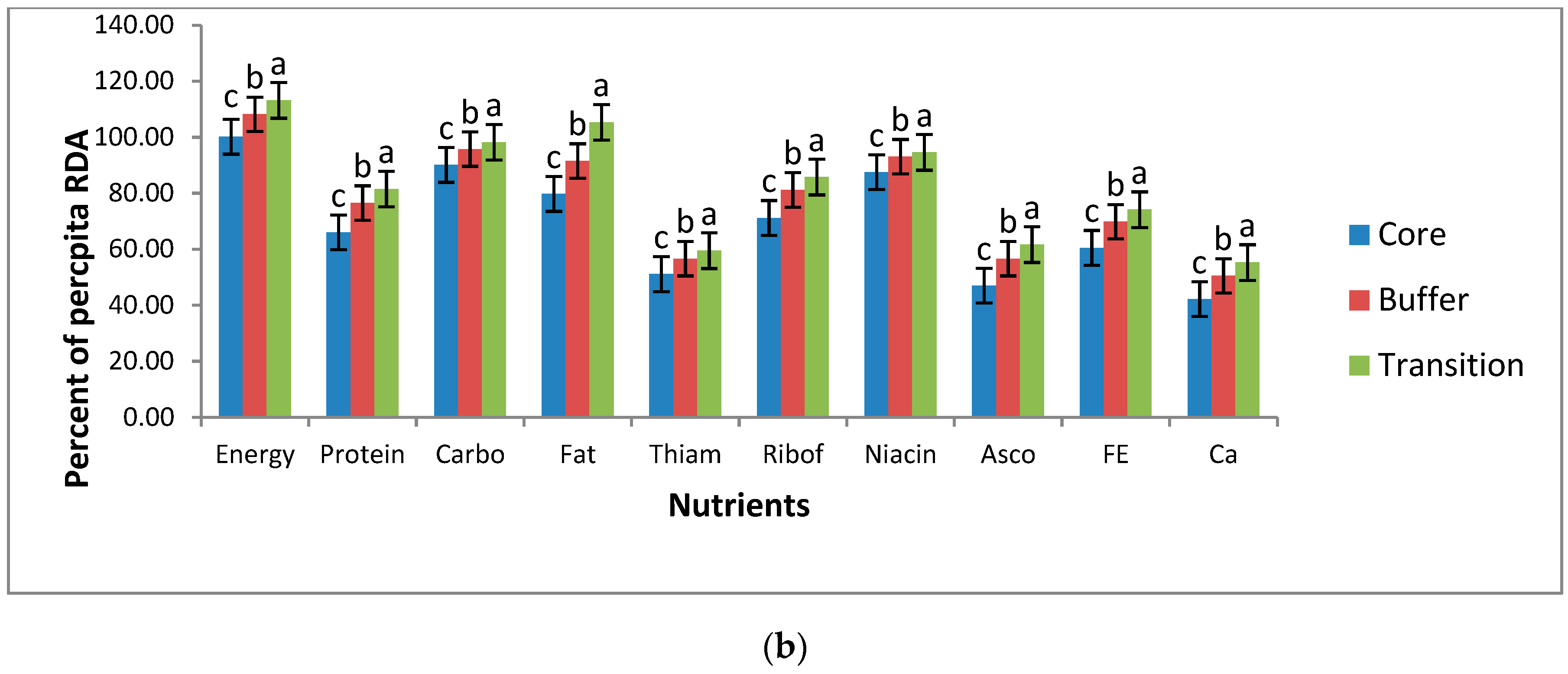
| Sl. No. | Village | Latitude | Longitude | Zone | House Holds | Total Population | M | F | L (%) | IC (%) | AU | Sample Households |
|---|---|---|---|---|---|---|---|---|---|---|---|---|
| 1 | Achanakmaar | Lormi | Mungeli | C | 130 | 535 | 283 | 252 | 64.18 | 36.1 | 15 | 20 |
| 2 | Surhi | Lormi | Mungeli | C | 205 | 802 | 400 | 402 | 55.60 | 79.1 | 16 | 31 |
| 3 | Lamni | Lormi | Mungeli | C | 147 | 634 | 354 | 280 | 57.56 | 78.1 | 18 | 22 |
| 4 | Birjakachar | Lormi | Mungeli | B | 286 | 979 | 481 | 498 | 30.60 | 70.5 | 18 | 43 |
| 5 | Khongsara | Kota | Bilaspur | B | 266 | 1052 | 526 | 527 | 57.44 | 75.2 | 12 | 40 |
| 6 | Telipani | Pandariya | Kabeerdham | B | 135 | 607 | 301 | 306 | 59.00 | 95.3 | 15 | 20 |
| 7 | Gorakhpur | Dindori | Dindori | T | 100 | 429 | 224 | 205 | 37.32 | 86.1 | 10 | 20 |
| 8 | Khodri | Gurella | Pendra Gurella Marwahi | T | 574 | 2244 | 1127 | 1117 | 77.14 | 29.1 | 11 | 87 |
| 9 | Shivtarai | Kota | Bilaspur | T | 325 | 1297 | 641 | 656 | 76.19 | 82.1 | 10 | 49 |
| Total | 2168 | 332 | ||||||||||
| S. No. | Factors | Core | Buffer | Transition | Total Score | Rank |
|---|---|---|---|---|---|---|
| 1 | Overgrazing | 2 | 2 | 4 | 9 | IV |
| 2 | Overharvesting and Faulty harvest methods | 2 | 4 | 5 | 11 | II |
| 3 | Encroachment for Agriculture | 3 | 4 | 5 | 12 | I |
| 4 | Uncontrolled forest fires | 1 | 1 | 4 | 6 | VII |
| 5 | Frequent droughts | 2 | 2 | 3 | 7 | VI |
| 6 | Protected mining activities | 1 | 1 | 2 | 4 | IX |
| 7 | Firewood and Timber | 2 | 3 | 3 | 8 | V |
| 8 | Expansion of roads and communication | 1 | 2 | 2 | 5 | VIII |
| 9 | Minor dam construction | 1 | 1 | 1 | 3 | X |
| 10 | Changing demands and marketing | 4 | 3 | 3 | 10 | III |
| Zone and RDA | Food Group | ||||||||
|---|---|---|---|---|---|---|---|---|---|
| Cereals | Pulses | Veggies | Fruit | Tubers | Milk and Product | Meat, Eggs and Fishes | Sugar and Jaggery | Oil and Fats | |
| Core | 476 ± 3.6 b | 17 ± 1.5 b | 86 ± 2.5 b | 70.5 ± 2.8 c | 34.0 ± 3.2 b | 50.0 ± 2.5 c | 8.2 ± 1.1 c | 13.0 ± 1.9 b | 20.0 ± 1.5 c |
| Buffer | 495 ± 3.8 a | 26 ± 2.1 a | 90 ± 3.6 a | 76.0 ± 2.5 b | 37.0 ± 3.4 a | 89.0 ± 1.6 b | 12.0 ± 1.8 b | 15.0 ± 1.8 ab | 22.0 ± 1.8 b |
| Transition | 500 ± 4.2 a | 30 ± 2.5 a | 93 ± 2.9 a | 82.5 ± 3.6 a | 33.0 ± 2.8 b | 111.0 ± 3.5 a | 14.6 ± 2.2 a | 18.2 ± 2.4 a | 26.0 ± 1.9 a |
| Average | 490.3 | 24.3 | 89.7 | 76.3 | 34.7 | 83.3 | 11.6 | 15.4 | 22.7 |
| RDA | 350 | 80 | 250 | 100 | 150 | 300 | 35 | 25 | 25 |
| Zone and RDA | Nutrients | |||||||||
|---|---|---|---|---|---|---|---|---|---|---|
| Energy (K Cal) | P (g) | C (g) | F (g) | T (mg) | R (mg) | N (mg) | A (mg) | Fe (mg) | Ca (mg) | |
| Core | 2203.9 ± 54.3 b | 33.0 ± 2.3 b | 360.4 ± 14.2 c | 30.3 ± 2.1 c | 1.0 ± 0.1 b | 1.1 ± 0.2 b | 13.1 ± 1.1 b | 32.9 ± 2.4 c | 13.9 ± 1.4 b | 421.9 ± 24.5 c |
| Buffer | 2379.7 ± 68.9 ab | 38.3 ± 2.8 a | 382.9 ± 213 b | 34.8 ± 2.3 b | 1.1 ± 0.2 a | 1.3 ± 0.1 b | 14.0 ± 1.5 a | 39.6 ± 2.8 b | 16.1 ± 1.2 a | 504.7 ± 26.7 b |
| Transition | 2489.1 ± 75.4 a | 40.8 ± 3.2 a | 393.0 ± 22.3 a | 40.0 ± 2.8 a | 1.2 ± 0.1 a | 1.4 ± 0.3 a | 14.2 ± 1.2 a | 43.1 ± 2.7 a | 17.0 ± 1.9 a | 552.5 ± 25.5 a |
| Average | 2357.5 | 37.3 | 378.8 | 35.0 | 1.1 | 1.3 | 13.8 | 38.6 | 15.7 | 493.0 |
| RDA | 2200 | 50 | 400 | 38 | 1.6 | 2 | 15 | 70 | 23 | 1000 |
| Zone | Nutrients | |||||||||
|---|---|---|---|---|---|---|---|---|---|---|
| Energy (Cal) | P (g) | C (g) | F (g) | T (mg) | R (mg) | N (mg) | A (mg) | Fe (mg) | Ca (mg) | |
| Core | 8.3 ± 0.8 a | 4.9 ± 0.5 a | 5.6 ± 0.4 a | 13.5 ± 16 a | 35.4 ± 3.2 a | 8.4 ± 2.6 b | 4.5 ± 0.5 a | 73.0 ± 8.2 a | 4.1 ± 1.8 a | 26.7 ± 4.2 a |
| Buffer | 6.5 ± 0.5 a | 4.0 ± 0.7 a | 5.0 ± 0.9 a | 6.0 ± 1.3 b | 28.9 ± 3.8 b | 11.5 ± 2.5 a | 4.2 ± 0.5 a | 57.2 ± 9.2 b | 5.4 ± 1.3 a | 29.1 ± 3.8 a |
| Transition | 3.7 ± 0.6 b | 1.1 ± 0.6 b | 3.2 ± 0.7 b | 2.6 ±1.4 c | 13.7 ± 4.2 | 2.4 ± 1.6 c | 1.2 ± 0.4 b | 38.1 ± 7.2 c | 1.1 ± 2.1 b | 17.2 ± 5.2 b |
| Mean | 6.2 | 3.3 | 4.6 | 7.4 | 26.0 | 7.4 | 3.3 | 56.1 | 3.5 | 24.3 |
Publisher’s Note: MDPI stays neutral with regard to jurisdictional claims in published maps and institutional affiliations. |
© 2021 by the authors. Licensee MDPI, Basel, Switzerland. This article is an open access article distributed under the terms and conditions of the Creative Commons Attribution (CC BY) license (https://creativecommons.org/licenses/by/4.0/).
Share and Cite
Mishra, A.; Swamy, S.L.; Thakur, T.K.; Bhat, R.; Bijalwan, A.; Kumar, A. Use of Wild Edible Plants: Can They Meet the Dietary and Nutritional Needs of Indigenous Communities in Central India. Foods 2021, 10, 1453. https://doi.org/10.3390/foods10071453
Mishra A, Swamy SL, Thakur TK, Bhat R, Bijalwan A, Kumar A. Use of Wild Edible Plants: Can They Meet the Dietary and Nutritional Needs of Indigenous Communities in Central India. Foods. 2021; 10(7):1453. https://doi.org/10.3390/foods10071453
Chicago/Turabian StyleMishra, Alka, Singam Laxmana Swamy, Tarun Kumar Thakur, Rajeev Bhat, Arvind Bijalwan, and Amit Kumar. 2021. "Use of Wild Edible Plants: Can They Meet the Dietary and Nutritional Needs of Indigenous Communities in Central India" Foods 10, no. 7: 1453. https://doi.org/10.3390/foods10071453
APA StyleMishra, A., Swamy, S. L., Thakur, T. K., Bhat, R., Bijalwan, A., & Kumar, A. (2021). Use of Wild Edible Plants: Can They Meet the Dietary and Nutritional Needs of Indigenous Communities in Central India. Foods, 10(7), 1453. https://doi.org/10.3390/foods10071453









